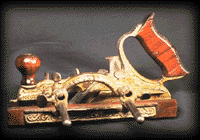|
|
 |
 |
 |
The Stanley 46 and 47: Skew-bladed Dado, Fillister and Plow
Planes
|
 |
|
The Stanley 46 looks almost identical to the Stanley 45, except that the cutters are
skewed or angled with respect to the bottom of the plane, and no beading or moulding
blades were offered with them. Early models of the 46 and 47 had no fence, although the
early 46's had a guard plate that attached to the outside skate to facilitate rabbeting.
The guard was dropped when the 46 was given a fence similar to the 45. (The 47 was only
ever an adjustable dado plane, it never had a fence or a guard plate so it couldn't be
used to rabbet or plow). |
 |
|
Planes with skew blades are hard to sharpen because the angle of the blade must be
maintained or else one side of the cutter will project lower than the other, and you won't
be able to set the blade evenly. Since the cutters are set at a skew angle, they are more
effective than straight cutters when working across the grain. This makes the plane much
more useful for doing things such as cutting dados. This plane also has spur cutters on
both skates which also help with all cross grain planing. To cut across grain the main
cutter must be razor sharp, as will the spur cutters. Again, set the spurs slightly lower
than the main cutter to slice the woodgrain in advance. The fence isn't used for cutting
dados but instead tack or clamp a thin piece of wood as a temporary guide for the inside
skate. We've never use the Stanley 46 or 47 as a dado plane - we have several sizes of Stanley 39 dado planes. Their set up is the
same, and they do an absolutely fantastic job. The Stanley 46 really
excels at cutting rabbets, and is much preferred to to the Stanley 41 or 45 planes. The
skew cutters help to keep the fence tight against the board, and the plane cuts tight
spiral shavings called "spills " which can run the entire length of the board. Besides being
satisfying to use, these planes make an impressive demonstration for our workshop and
provides convenient "fire starters" for the museum's bread oven. " which can run the entire length of the board. Besides being
satisfying to use, these planes make an impressive demonstration for our workshop and
provides convenient "fire starters" for the museum's bread oven. |

 |
|
The Stanley 47 uses the same castings as the 46, but the front right depth stop is
ground off. Being less expensive than the 46, it also came with fewer cutters and no fence
or guard plate. The 47 pictured here is an earlier japanned model and includes an outside
skate that was taken from an early 46. The Stanley 46 is a slightly later model with
nickel plating and a piece of rosewood on the fence.  
Copyright 1999 01 Inc., NYC |



![]() " which can run the entire length of the board. Besides being
satisfying to use, these planes make an impressive demonstration for our workshop and
provides convenient "fire starters" for the museum's bread oven.
" which can run the entire length of the board. Besides being
satisfying to use, these planes make an impressive demonstration for our workshop and
provides convenient "fire starters" for the museum's bread oven.
